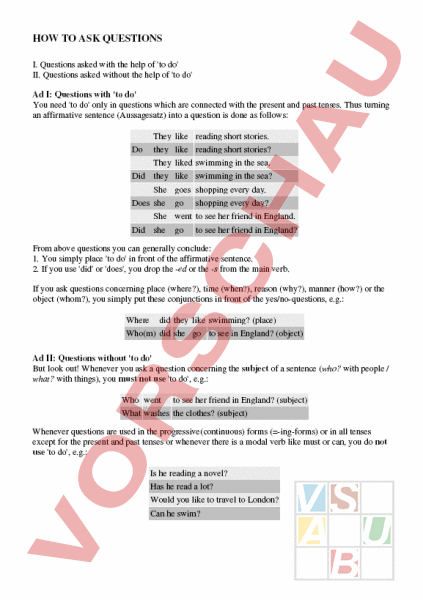Arbeitsblatt: questions
Material-Details
Questions are here.
Englisch
Grammatik
8. Schuljahr
1 Seiten
Statistik
21952
741
4
03.07.2008
Autor/in
Amann Karl Amann
Land: Deutschland
Registriert vor 2006
Textauszüge aus dem Inhalt:
HOW TO ASK QUESTIONS I. Questions asked with the help of to do II. Questions asked without the help of to do Ad I: Questions with to do You need to do only in questions which are connected with the present and past tenses. Thus turning an affirmative sentence (Aussagesatz) into question is done as follows: They like reading short stories. Do they like reading short stories? They liked swimming in the sea. Did they like swimming in the sea? She goes shopping every day. Does she go shopping every day? She went to see her friend in England. Did she go to see her friend in England? From above questions you can generally conclude: 1. You simply place to do in front of the affirmative sentence. 2. If you use did or does, you drop the -ed or the -s from the main verb. If you ask questions concerning place (where?), time (when?), reason (why?), manner (how?) or the object (whom?), you simply put these conjunctions in front of the yes/no-questions, e.g.: Where did they like swimming? (place) Who(m) did she go to see in England? (object) Ad II: Questions without to do But look out! Whenever you ask question concerning the subject of sentence (who? with people what? with things), you must not use to do, e.g.: Who went to see her friend in England? (subject) What washes the clothes? (subject) Whenever questions are used in the progressive(continuous) forms (-ing-forms) or in all tenses except for the present and past tenses or whenever there is modal verb like must or can, you do not use to do, e.g.: Is he reading novel? Has he read lot? Would you like to travel to London? Can he swim?
